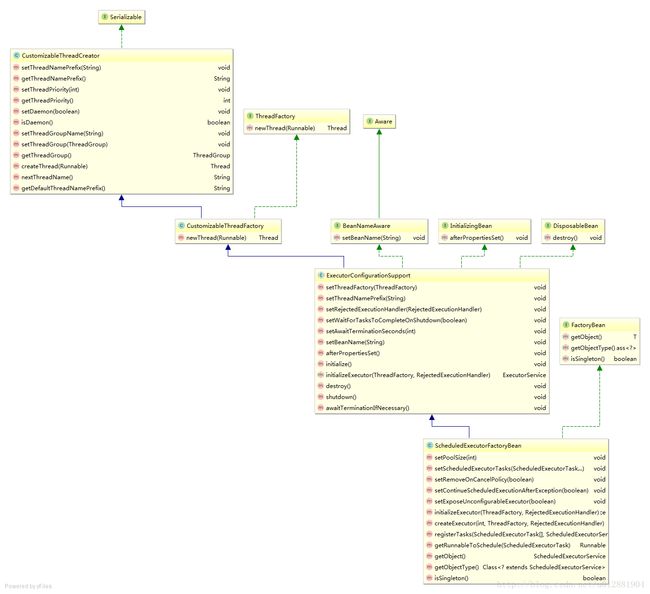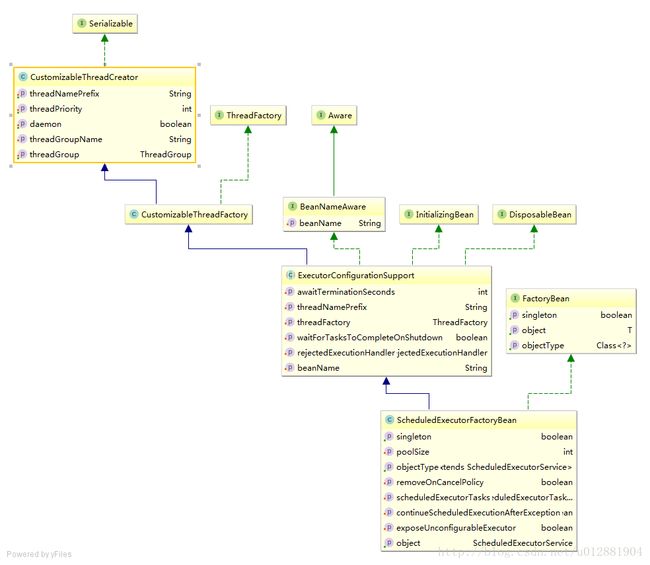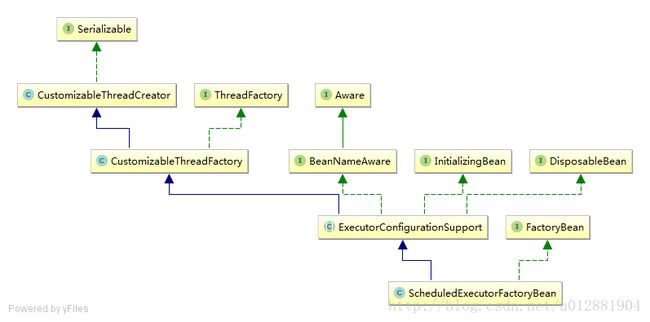Spring定时任务的实现方式--ScheduledExecutorService and ScheduledExecutorFactoryBean的简单源码解析以及使用
ScheduledExecutorFactoryBean的简单源码解析以及使用
ScheduledExecutorFactoryBean 配合ScheduledExecutorTask将JDK原来的ScheduledExecutorService提供的三种API进行了统一的封装,使用相同的方式去执行,非常的便捷,封装的思路也是比较厉害的,很多的东西值得我们去思考和学习。
原生的ScheduledExecutorService的使用一共有三种API的使用
package com.common.utils.ScheduledExecutor;
import lombok.extern.slf4j.Slf4j;
import java.text.SimpleDateFormat;
import java.util.Date;
import java.util.concurrent.Executors;
import java.util.concurrent.ScheduledExecutorService;
import java.util.concurrent.TimeUnit;
/**
* descrption: JDKScheduledExecutorService的使用、
* authohr: wangji
* date: 2017-10-10 15:29
*/
@Slf4j
public class ScheduledExecutorServiceTest {
public static void main(String[] args) {
//schdule();
//scheduleWithFixedDelay();
//scheduleAtFixedRate1();
scheduleAtFixedRate2();
}
// schedule(Runnable command, long delay, TimeUnit unit)
//schedule方法被用来延迟指定时间后执行某个指定任务。
public static void schdule() {
// 开始:2017-10-10 03:31:59
// 测试schedule方法:2017-10-10 03:32:00
ScheduledExecutorService schedule = Executors.newScheduledThreadPool(5);
final SimpleDateFormat sdf = new SimpleDateFormat("yyyy-MM-dd hh:mm:ss");
System.out.println("开始:" + sdf.format(new Date()));
schedule.schedule(new Runnable() {
public void run() {
System.out.println("测试schedule方法:"+sdf.format(new Date()));
}
},1, TimeUnit.SECONDS);
}
// scheduleWithFixedDelay(Runnable command, long initialDelay, long delay,TimeUnit unit)
// 创建并执行一个在给定初始延迟后首次启用的定期操作,随后,
// 在每一次执行终止和下一次执行开始之间都存在给定的延迟,
// 如果任务的执行时间超过了廷迟时间(delay),
// 下一个任务则会在(当前任务执行所需时间+delay)后执行。
public static void scheduleWithFixedDelay(){
// 开始:2017-10-10 03:35:02
// 测试scheduleWithFixedDelay方法:2017-10-10 03:35:06 初始化花了4秒
// 测试scheduleWithFixedDelay方法:2017-10-10 03:35:11 延迟两秒+睡眠3秒(下一次五秒)
// 测试scheduleWithFixedDelay方法:2017-10-10 03:35:16
// 测试scheduleWithFixedDelay方法:2017-10-10 03:35:21
ScheduledExecutorService schedule = Executors.newScheduledThreadPool(5);
final SimpleDateFormat sdf = new SimpleDateFormat("yyyy-MM-dd hh:mm:ss");
System.out.println("开始:" + sdf.format(new Date()));
schedule.scheduleWithFixedDelay(new Runnable() {
public void run() {
try {
Thread.sleep(3000);
} catch (InterruptedException ex) {
ex.printStackTrace();
}
System.out.println("测试scheduleWithFixedDelay方法:"+sdf.format(new Date()));
}
},1,2, TimeUnit.SECONDS);
}
//scheduleAtFixedRate(Runnable command, long initialDelay, long period, TimeUnit unit)
//创建并执行一个在给定初始延迟后首次启用的定期操作,后续操作具有给定的周期;也就是将在 initialDelay 后开始执行,
// 然后在initialDelay+period 后执行,接着在 initialDelay + 2 * period 后执行,依此类推。
//如果任务的执行时间小于period,将会按上述规律执行。否则,则会按任务的实际执行时间进行周期执行。
// command:执行线程
// initialDelay:初始化延时
// period:两次开始执行最小间隔时间
// unit:计时单位
public static void scheduleAtFixedRate1(){
// 开始:2017-10-10 03:43:41
// 测试scheduleAtFixedRate方法:2017-10-10 03:43:45
// 测试scheduleAtFixedRate方法:2017-10-10 03:43:50
// 从上面的测试结果可以看到如果任务的执行时间小于period,每次间隔period执行一次任务。
ScheduledExecutorService schedule = Executors.newScheduledThreadPool(5);
final SimpleDateFormat sdf = new SimpleDateFormat("yyyy-MM-dd hh:mm:ss");
System.out.println("开始:" + sdf.format(new Date()));
schedule.scheduleAtFixedRate(new Runnable() {
public void run() {
try {
Thread.sleep(3000);
} catch (InterruptedException ex) {
ex.printStackTrace();
}
System.out.println("测试scheduleAtFixedRate方法:"+sdf.format(new Date()));
}
},1,5, TimeUnit.SECONDS);
}
//测试代码(任务的执行时间大于period)
public static void scheduleAtFixedRate2(){
ScheduledExecutorService schedule = Executors.newScheduledThreadPool(5);
final SimpleDateFormat sdf = new SimpleDateFormat("yyyy-MM-dd hh:mm:ss");
System.out.println("开始:" + sdf.format(new Date()));
schedule.scheduleAtFixedRate(new Runnable() {
public void run() {
try {
Thread.sleep(3000);
} catch (InterruptedException ex) {
ex.printStackTrace();
}
System.out.println("测试scheduleAtFixedRate方法:"+sdf.format(new Date()));
}
},1,2, TimeUnit.SECONDS);
}
// 开始:2017-10-10 03:45:55
// 测试scheduleAtFixedRate方法:2017-10-10 03:45:59
// 测试scheduleAtFixedRate方法:2017-10-10 03:46:02
// 测试scheduleAtFixedRate方法:2017-10-10 03:46:05
// 测试scheduleAtFixedRate方法:2017-10-10 03:46:08
// 测试scheduleAtFixedRate方法:2017-10-10 03:46:11
// 从上面的测试结果可以看到如果任务的执行时间大于period,则会按任务的实际执行时间进行周期执行
}
ScheduledExecutorTask 就是将着三种不同的周期执行函数进行统一封装
public class ScheduledExecutorTask {
private Runnable runnable;//执行的线程
private long delay = 0;
private long period = -1;//周期性时间或者延迟时间或者用0表示只执行一次,将三种API都使用起来了
private TimeUnit timeUnit = TimeUnit.MILLISECONDS;
private boolean fixedRate = false;
}如果配置period=0将执行这个方法:schedule(Runnable command, long delay, TimeUnit unit),schedule方法被用来延迟指定时间后执行某个指定任务
只执行一次如果配置fixedRate = true && period>0 将执行这方法 scheduleAtFixedRate(Runnable command, long initialDelay, long period, TimeUnit unit)
固定的频率,如果任务的周期大于peroid,将使用任务的周期作为频率如果配置fixdRate = false period>0 将执行这个方法 scheduleWithFixedDelay(Runnable command, long initialDelay, long delay,TimeUnit unit)
有延迟的执行,initialDelay与delay相同 delay与peroid这个值相同
只是将Runable简单的包装一下子,具体看下面的cheduledExecutorFactoryBean#registerTasks
public class ScheduledExecutorTask {
private Runnable runnable;
private long delay = 0L;
private long period = -1L;
private TimeUnit timeUnit;
private boolean fixedRate;
public ScheduledExecutorTask() {
this.timeUnit = TimeUnit.MILLISECONDS;
this.fixedRate = false;
}
public ScheduledExecutorTask(Runnable executorTask) {
this.timeUnit = TimeUnit.MILLISECONDS;
this.fixedRate = false;
this.runnable = executorTask;
}
....
}ScheduledExecutorFactoryBean,工厂Bean,可以通过getObject或者到当前配置的实例,工厂Bean的作用就是简化我们的配置,将大大减少工作量
程序的入口点为 实现了InitializingBean初始化Bean完成之后执行方法
父类ExecutorConfigurationSupport 初始化
public void afterPropertiesSet() {
initialize();
}
/**
* Set up the ExecutorService.
*/
public void initialize() {
if (logger.isInfoEnabled()) {
logger.info("Initializing ExecutorService " + (this.beanName != null ? " '" + this.beanName + "'" : ""));
}
if (!this.threadNamePrefixSet && this.beanName != null) {
setThreadNamePrefix(this.beanName + "-");
}
this.executor = initializeExecutor(this.threadFactory, this.rejectedExecutionHandler);
}
//放置给后代的钩子函数
protected abstract ExecutorService initializeExecutor(
ThreadFactory threadFactory, RejectedExecutionHandler rejectedExecutionHandler);
ScheduledExecutorFactoryBean 实现了这个方法 initializeExecutor,初始化线程池,以及将任务注入到线程池中,还有进行一些异常出现后的包装
@Override
@UsesJava7
protected ExecutorService initializeExecutor(
ThreadFactory threadFactory, RejectedExecutionHandler rejectedExecutionHandler) {
//使用JDK的API创建一个ScheduledExecutorService
// new ScheduledThreadPoolExecutor(poolSize, threadFactory, rejectedExecutionHandler);
ScheduledExecutorService executor =
createExecutor(this.poolSize, threadFactory, rejectedExecutionHandler);
//设置removeOncancle属性
if (this.removeOnCancelPolicy) {
if (setRemoveOnCancelPolicyAvailable && executor instanceof ScheduledThreadPoolExecutor) {
((ScheduledThreadPoolExecutor) executor).setRemoveOnCancelPolicy(true);
}
else {
logger.info("Could not apply remove-on-cancel policy - not a Java 7+ ScheduledThreadPoolExecutor");
}
}
// 创建特殊的task放置在线程池中,Register specified ScheduledExecutorTasks, if necessary.
//这里是非常重要的逻辑步骤了
if (!ObjectUtils.isEmpty(this.scheduledExecutorTasks)) {
registerTasks(this.scheduledExecutorTasks, executor);
}
// Wrap executor with an unconfigurable decorator.进行一下包装,不允许修改属性
this.exposedExecutor = (this.exposeUnconfigurableExecutor ?
Executors.unconfigurableScheduledExecutorService(executor) : executor);
return executor;
}对于三种不同的API区分的实现
protected void registerTasks(ScheduledExecutorTask[] tasks, ScheduledExecutorService executor) {
for (ScheduledExecutorTask task : tasks) {
//包装任务,掏出异常是否继续进行执行
Runnable runnable = getRunnableToSchedule(task);
// public boolean isOneTimeTask() {
// return (this.period <= 0);
// }
if (task.isOneTimeTask()) {
executor.schedule(runnable, task.getDelay(), task.getTimeUnit());
}
else {
if (task.isFixedRate()) {
executor.scheduleAtFixedRate(runnable, task.getDelay(), task.getPeriod(), task.getTimeUnit());
}
else {
executor.scheduleWithFixedDelay(runnable, task.getDelay(), task.getPeriod(), task.getTimeUnit());
}
}
}
}对于任务进行包装,执行任务异常之后是否继续进行下一次的任务呀
/**
* Determine the actual Runnable to schedule for the given task.
* Wraps the task's Runnable in a
* {@link org.springframework.scheduling.support.DelegatingErrorHandlingRunnable}
* that will catch and log the Exception. If necessary, it will suppress the
* Exception according to the
* {@link #setContinueScheduledExecutionAfterException "continueScheduledExecutionAfterException"}
* flag.
* @param task the ScheduledExecutorTask to schedule
* @return the actual Runnable to schedule (may be a decorator)
*/
protected Runnable getRunnableToSchedule(ScheduledExecutorTask task) {
return (this.continueScheduledExecutionAfterException ?
new DelegatingErrorHandlingRunnable(task.getRunnable(), TaskUtils.LOG_AND_SUPPRESS_ERROR_HANDLER) :
new DelegatingErrorHandlingRunnable(task.getRunnable(), TaskUtils.LOG_AND_PROPAGATE_ERROR_HANDLER));
}
public class DelegatingErrorHandlingRunnable implements Runnable {
private final Runnable delegate;
private final ErrorHandler errorHandler;
/**
* Create a new DelegatingErrorHandlingRunnable.
* @param delegate the Runnable implementation to delegate to
* @param errorHandler the ErrorHandler for handling any exceptions
*/
public DelegatingErrorHandlingRunnable(Runnable delegate, ErrorHandler errorHandler) {
Assert.notNull(delegate, "Delegate must not be null");
Assert.notNull(errorHandler, "ErrorHandler must not be null");
this.delegate = delegate;
this.errorHandler = errorHandler;
}
@Override
public void run() {
try {
this.delegate.run();
}
catch (UndeclaredThrowableException ex) {
this.errorHandler.handleError(ex.getUndeclaredThrowable());
}
catch (Throwable ex) {
this.errorHandler.handleError(ex);
}
}
@Override
public String toString() {
return "DelegatingErrorHandlingRunnable for " + this.delegate;
}
}
private static class LoggingErrorHandler implements ErrorHandler {
private final Log logger = LogFactory.getLog(LoggingErrorHandler.class);
@Override
public void handleError(Throwable t) {
if (logger.isErrorEnabled()) {
logger.error("Unexpected error occurred in scheduled task.", t);
}
}
}
private static class PropagatingErrorHandler extends LoggingErrorHandler {
@Override
public void handleError(Throwable t) {
super.handleError(t);
ReflectionUtils.rethrowRuntimeException(t);
}
}
使用
<beans xmlns="http://www.springframework.org/schema/beans"
xmlns:xsi="http://www.w3.org/2001/XMLSchema-instance" xmlns:mvc="http://www.springframework.org/schema/mvc"
xmlns:context="http://www.springframework.org/schema/context"
xmlns:aop="http://www.springframework.org/schema/aop" xmlns:tx="http://www.springframework.org/schema/tx"
xsi:schemaLocation="http://www.springframework.org/schema/beans
http://www.springframework.org/schema/beans/spring-beans-3.2.xsd
http://www.springframework.org/schema/context
http://www.springframework.org/schema/context/spring-context-3.2.xsd
http://www.springframework.org/schema/aop
http://www.springframework.org/schema/aop/spring-aop-3.2.xsd
http://www.springframework.org/schema/tx
http://www.springframework.org/schema/tx/spring-tx-3.2.xsd ">
<bean id="startupScheduledTask" class="org.springframework.scheduling.concurrent.ScheduledExecutorTask">
<property name="fixedRate" value="false">property>
<property name="delay" value="3000" />
<property name="period" value="3000" />
<property name="runnable">
<bean class="com.common.utils.ScheduledExecutor.StartupTask">bean>
property>
bean>
<bean id="timerFactory" class="org.springframework.scheduling.concurrent.ScheduledExecutorFactoryBean">
<property name="scheduledExecutorTasks">
<list>
<ref bean="startupScheduledTask" />
list>
property>
<property name="continueScheduledExecutionAfterException" value="true">property>
<property name="poolSize" value="2">property>
bean>
beans>package com.common.utils.ScheduledExecutor;
import lombok.extern.slf4j.Slf4j;
import java.util.Date;
/**
* descrption: spring中配置使用的一个简单的线程
* authohr: wangji
* date: 2017-10-10 18:24
*/
@Slf4j
public class StartupTask implements Runnable {
public void run() {
try {
Thread.sleep(3000);
} catch (InterruptedException e) {
log.error("线程中断",e);
}
log.info(new Date()+" ScheduledExecutorTask...");
}
}源码:
public class ScheduledExecutorFactoryBean extends ExecutorConfigurationSupport implements FactoryBean<ScheduledExecutorService> {
private static final boolean setRemoveOnCancelPolicyAvailable;
private int poolSize = 1;
private ScheduledExecutorTask[] scheduledExecutorTasks;
private boolean removeOnCancelPolicy = false;
private boolean continueScheduledExecutionAfterException = false;
private boolean exposeUnconfigurableExecutor = false;
private ScheduledExecutorService exposedExecutor;
public ScheduledExecutorFactoryBean() {
}
public void setPoolSize(int poolSize) {
Assert.isTrue(poolSize > 0, "\'poolSize\' must be 1 or higher");
this.poolSize = poolSize;
}
public void setScheduledExecutorTasks(ScheduledExecutorTask... scheduledExecutorTasks) {
this.scheduledExecutorTasks = scheduledExecutorTasks;
}
public void setRemoveOnCancelPolicy(boolean removeOnCancelPolicy) {
this.removeOnCancelPolicy = removeOnCancelPolicy;
}
public void setContinueScheduledExecutionAfterException(boolean continueScheduledExecutionAfterException) {
this.continueScheduledExecutionAfterException = continueScheduledExecutionAfterException;
}
public void setExposeUnconfigurableExecutor(boolean exposeUnconfigurableExecutor) {
this.exposeUnconfigurableExecutor = exposeUnconfigurableExecutor;
}
@UsesJava7
protected ExecutorService initializeExecutor(ThreadFactory threadFactory, RejectedExecutionHandler rejectedExecutionHandler) {
ScheduledExecutorService executor = this.createExecutor(this.poolSize, threadFactory, rejectedExecutionHandler);
if(this.removeOnCancelPolicy) {
if(setRemoveOnCancelPolicyAvailable && executor instanceof ScheduledThreadPoolExecutor) {
((ScheduledThreadPoolExecutor)executor).setRemoveOnCancelPolicy(true);
} else {
this.logger.info("Could not apply remove-on-cancel policy - not a Java 7+ ScheduledThreadPoolExecutor");
}
}
if(!ObjectUtils.isEmpty(this.scheduledExecutorTasks)) {
this.registerTasks(this.scheduledExecutorTasks, executor);
}
this.exposedExecutor = this.exposeUnconfigurableExecutor?Executors.unconfigurableScheduledExecutorService(executor):executor;
return executor;
}
protected ScheduledExecutorService createExecutor(int poolSize, ThreadFactory threadFactory, RejectedExecutionHandler rejectedExecutionHandler) {
return new ScheduledThreadPoolExecutor(poolSize, threadFactory, rejectedExecutionHandler);
}
protected void registerTasks(ScheduledExecutorTask[] tasks, ScheduledExecutorService executor) {
ScheduledExecutorTask[] var3 = tasks;
int var4 = tasks.length;
for(int var5 = 0; var5 < var4; ++var5) {
ScheduledExecutorTask task = var3[var5];
Runnable runnable = this.getRunnableToSchedule(task);
if(task.isOneTimeTask()) {
executor.schedule(runnable, task.getDelay(), task.getTimeUnit());
} else if(task.isFixedRate()) {
executor.scheduleAtFixedRate(runnable, task.getDelay(), task.getPeriod(), task.getTimeUnit());
} else {
executor.scheduleWithFixedDelay(runnable, task.getDelay(), task.getPeriod(), task.getTimeUnit());
}
}
}
protected Runnable getRunnableToSchedule(ScheduledExecutorTask task) {
return this.continueScheduledExecutionAfterException?new DelegatingErrorHandlingRunnable(task.getRunnable(), TaskUtils.LOG_AND_SUPPRESS_ERROR_HANDLER):new DelegatingErrorHandlingRunnable(task.getRunnable(), TaskUtils.LOG_AND_PROPAGATE_ERROR_HANDLER);
}
public ScheduledExecutorService getObject() {
return this.exposedExecutor;
}
public Class getObjectType() {
return this.exposedExecutor != null?this.exposedExecutor.getClass():ScheduledExecutorService.class;
}
public boolean isSingleton() {
return true;
}
static {
setRemoveOnCancelPolicyAvailable = ClassUtils.hasMethod(ScheduledThreadPoolExecutor.class, "setRemoveOnCancelPolicy", new Class[]{Boolean.TYPE});
}
}
public abstract class ExecutorConfigurationSupport extends CustomizableThreadFactory implements BeanNameAware, InitializingBean, DisposableBean {
protected final Log logger = LogFactory.getLog(this.getClass());
private ThreadFactory threadFactory = this;
private boolean threadNamePrefixSet = false;
private RejectedExecutionHandler rejectedExecutionHandler = new AbortPolicy();
private boolean waitForTasksToCompleteOnShutdown = false;
private int awaitTerminationSeconds = 0;
private String beanName;
private ExecutorService executor;
public ExecutorConfigurationSupport() {
}
public void setThreadFactory(ThreadFactory threadFactory) {
this.threadFactory = (ThreadFactory)(threadFactory != null?threadFactory:this);
}
public void setThreadNamePrefix(String threadNamePrefix) {
super.setThreadNamePrefix(threadNamePrefix);
this.threadNamePrefixSet = true;
}
public void setRejectedExecutionHandler(RejectedExecutionHandler rejectedExecutionHandler) {
this.rejectedExecutionHandler = (RejectedExecutionHandler)(rejectedExecutionHandler != null?rejectedExecutionHandler:new AbortPolicy());
}
public void setWaitForTasksToCompleteOnShutdown(boolean waitForJobsToCompleteOnShutdown) {
this.waitForTasksToCompleteOnShutdown = waitForJobsToCompleteOnShutdown;
}
public void setAwaitTerminationSeconds(int awaitTerminationSeconds) {
this.awaitTerminationSeconds = awaitTerminationSeconds;
}
public void setBeanName(String name) {
this.beanName = name;
}
public void afterPropertiesSet() {
this.initialize();
}
public void initialize() {
if(this.logger.isInfoEnabled()) {
this.logger.info("Initializing ExecutorService " + (this.beanName != null?" \'" + this.beanName + "\'":""));
}
if(!this.threadNamePrefixSet && this.beanName != null) {
this.setThreadNamePrefix(this.beanName + "-");
}
this.executor = this.initializeExecutor(this.threadFactory, this.rejectedExecutionHandler);
}
protected abstract ExecutorService initializeExecutor(ThreadFactory var1, RejectedExecutionHandler var2);
public void destroy() {
this.shutdown();
}
public void shutdown() {
if(this.logger.isInfoEnabled()) {
this.logger.info("Shutting down ExecutorService" + (this.beanName != null?" \'" + this.beanName + "\'":""));
}
if(this.waitForTasksToCompleteOnShutdown) {
this.executor.shutdown();
} else {
this.executor.shutdownNow();
}
this.awaitTerminationIfNecessary();
}
private void awaitTerminationIfNecessary() {
if(this.awaitTerminationSeconds > 0) {
try {
if(!this.executor.awaitTermination((long)this.awaitTerminationSeconds, TimeUnit.SECONDS) && this.logger.isWarnEnabled()) {
this.logger.warn("Timed out while waiting for executor" + (this.beanName != null?" \'" + this.beanName + "\'":"") + " to terminate");
}
} catch (InterruptedException var2) {
if(this.logger.isWarnEnabled()) {
this.logger.warn("Interrupted while waiting for executor" + (this.beanName != null?" \'" + this.beanName + "\'":"") + " to terminate");
}
Thread.currentThread().interrupt();
}
}
}
}

